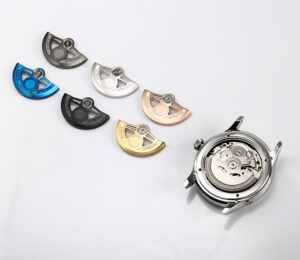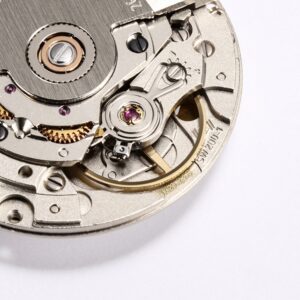For hundreds of years, the art of watchmaking has evolved alongside advances in material science. From early copper mechanisms to today’s high-tech ceramics and silicon components, each generation of innovation has shaped the precision, durability, and aesthetics of timepieces.
At WatchesHome, we believe that understanding materials is the foundation of appreciating true horological craftsmanship. Below is an in-depth look at the metals, non-metals, and advanced materials that define modern watchmaking.
1. Metal Materials in Watchmaking
Copper
Copper has been one of the earliest metals used in watch production. Lead brass—an alloy of copper, aluminum, and a small amount of lead—is commonly used for movement plates, wheels, and dials due to its machinability and stability.
Steel
Free-cutting steel remains the backbone of watch components. It is widely used for gear shafts, escapement wheels, and other precise internal parts that require high strength and resistance to wear.
Stainless Steel (316L & 904L)
Stainless steel is now the most popular material for modern watch cases, back covers, and bracelets.
-
316L Stainless Steel (European standard) offers excellent corrosion and wear resistance. Its surface can achieve multiple finishes—polished, brushed, or sandblasted—without electroplating.
-
904L Stainless Steel, used by premium brands such as Rolex, is harder, denser, and even more corrosion-resistant. It is about three times more expensive than 316L and preferred for luxury-grade timepieces.
Precious Metals: Gold, Silver, and Platinum
Gold, silver, and platinum represent the pinnacle of luxury in watchmaking.
-
18K Gold is the most common alloy (75% pure gold), available in yellow, rose, red, or white tones.
-
White Gold (K Gold) is often plated to achieve its platinum-like sheen.
-
Silver was historically popular in pocket watches but has faded due to oxidation issues.
-
Platinum (Pt950) is the most prestigious of all precious metals—dense, corrosion-resistant, and eternally brilliant.
Titanium and Special Alloys
Titanium is a revolutionary material in modern watch design—lightweight yet extremely strong and hypoallergenic. Its relative density is only half that of stainless steel, making it ideal for sports and diving watches.
Advanced alloys, such as tungsten carbide and nickel-chromium composites, add superior hardness and wear resistance, seen in brands like Panerai, TAG Heuer, and Rado.
2. Non-Metallic Materials
Carbon Fiber
Carbon fiber combines cutting-edge performance with striking aesthetics. Lighter than aluminum yet stronger than steel, it offers exceptional corrosion and heat resistance.
Originally used in aerospace applications, carbon fiber is now featured in high-end sports watches from Audemars Piguet, Tissot, and Bell & Ross.
Ceramics and High-Tech Ceramics
Ceramics are prized for their smooth texture, scratch resistance, and hypoallergenic properties.
-
High-tech ceramics, made from sintered aluminum oxide or carbonized powder, achieve a hardness of Mohs 8–9 (second only to diamonds).
-
Brands such as Rado, Chanel, and Glashütte Original have popularized ceramic cases for their modern elegance and durability.
Leather and Natural Materials
From traditional cowhide to exotic crocodile or ostrich leather, natural materials add comfort and sophistication to watch straps. Artificial leathers are also used for affordable models, providing more sustainable options.
3. Advanced and Modern Materials
Silicone Rubber
Silicone rubber straps have become a favorite in sports and diving watches. They are flexible, waterproof, and tested for UV resistance, seawater corrosion, and non-toxicity—ensuring both comfort and longevity.
Sapphire Crystal
Sapphire crystal is one of the most important innovations in modern horology.
-
Made from synthetic aluminum oxide, it achieves a Mohs hardness of 9, second only to diamond.
-
It provides superior scratch resistance and optical clarity.
-
Anti-reflective coatings (AR coatings) further enhance legibility in bright environments.
Luxury brands like Omega, Rolex, and Patek Philippe use sapphire glass as standard for high-end models.
Enamel Art
Enamel dials and cases remain a hallmark of fine watchmaking. Techniques like cloisonné, champlevé, and micro-paint enamel transform watches into miniature works of art.
Tritium and Luminous Innovations
Modern luminous technology—such as tritium gas illumination—provides long-lasting brightness for 24 hours a day, up to 25 years, without radiation risk.
Silicon Components
Since 2003, silicon has revolutionized movement design. Silicon hairsprings, escapements, and balance wheels offer superior anti-magnetic properties, no lubrication requirements, and minimal friction.
Prestigious watchmakers like Patek Philippe, Rolex, and Ulysse Nardin now integrate silicon components to achieve unparalleled precision.
4. The Essence of Quality: Materials Define Craftsmanship
In fine watchmaking, over 95% of a watch’s total weight and durability depend on its materials. From the corrosion resistance of 316L steel to the brilliance of sapphire crystal and the innovation of silicon parts, each material tells the story of technological advancement and artistic dedication.
At Watcheshome, we carefully select and craft every component—metal or non-metal—to embody both heritage and innovation. Whether it’s a tourbillon masterpiece, a titanium sports watch, or an elegant jewelry timepiece, the soul of each watch begins with its material.







